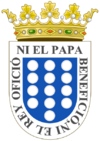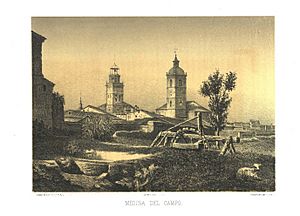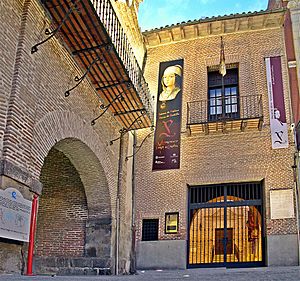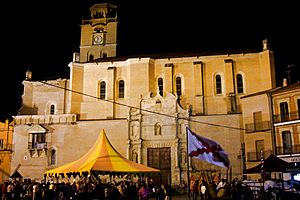Medina del Campo facts for kids
Quick facts for kids
Medina del Campo
|
|||
|---|---|---|---|
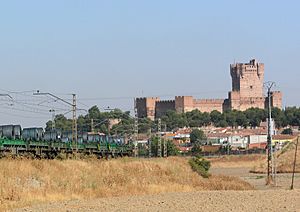
View of the city
|
|||
|
|||
| Country | Spain | ||
| Autonomous community | Castile and León | ||
| Province | Valladolid | ||
| Area | |||
| • Total | 153.27 km2 (59.18 sq mi) | ||
| Elevation | 720 m (2,360 ft) | ||
| Population
(2018)
|
|||
| • Total | 20,583 | ||
| • Density | 134.292/km2 (347.816/sq mi) | ||
| Demonym(s) | Medinenses | ||
| Time zone | UTC+1 (CET) | ||
| • Summer (DST) | UTC+2 (CEST) | ||
| Postal code |
47400
|
||
Medina del Campo is a town and municipality in Spain. It is located in the region of Castile and León. This town is part of the Province of Valladolid and is a central place for farming.
Contents
History of Medina del Campo
Medina del Campo became very important because of its big markets, called fairs, in the 1400s and 1500s. These fairs helped the town with banking and trading many things like wool, clothes, and books. As more people moved in, the town grew towards the Zapardiel brook. The Padilla Street then became the main business area.
In 1489, a big trade agreement was signed here. It was called the Treaty of Medina del Campo (1489). This agreement brought Spain and England closer. They agreed to lower trade taxes and see France as a shared enemy. It also led to the marriage of Catherine of Aragon to Prince Arthur of England, who was later married to King Henry VIII.
During the Revolt of the Comuneros, Medina del Campo was a major town. It stored the king's cannons. When the king's army tried to take these cannons, the town fought back. This fight ended with the burning of the city.
In the 1500s, Medina del Campo was very successful. Its fair became the most important among the big fairs in Castile. Many international traders came here, especially from Spain, Portugal, Italy, and Flanders. Some merchants also came from France, England, and Germany.
A thriving Jewish community once lived in Medina del Campo. However, they left after the expulsion of the Jews in 1492.
Between the 1600s and 1800s, the town faced a decline. More people started working in farming during this time.
Medina del Campo started to grow again in the late 1800s. This was thanks to the arrival of the railway and the opening of a military base. A health spa called Las Salinas also opened. The town also had a strong trading sector, especially for furniture. Shops even started opening on Sundays, which was unusual in Spain. The nearby high-quality wines from the Rueda region also helped the town's growth.
Main Places to See
Most of the beautiful old buildings in Medina del Campo are from the 1500s. Examples include the Casa Blanca country house, the Palacio de Dueñas, and the Hospital of Simón Ruiz. Rich merchants who became wealthy from the big Spanish Kingdom Fairs built these places. Today, there is a Museum of the Fairs that shows items related to these old markets. It is a popular place to visit.
The word "Medina" means "city" in Arabic (المدينة). Medina del Campo was founded on a hill called La Mota in the 1000s. This is where the Castle stands today, and parts of an old wall are still there. In the Middle Ages, La Mota hill was the town center. Now, it is a suburban area.
This hill also has old remains, like a fort, a medieval village, and a Celtic walled settlement from the 4th century BC (the Iron Age).
Castle of La Mota
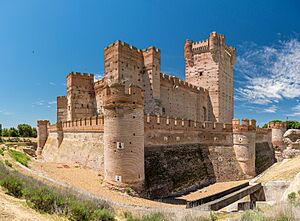
The word Mota refers to a man-made hill built to better protect the castle. The Mota fortress was used for military purposes. It was also a royal dungeon, where famous prisoners like Cesare Borgia were held. The castle was built between the 1100s and 1400s. It has a moat with a drawbridge (now fixed). It also has an outer wall for artillery and an inner wall with arrow slits for archers. Inside, there is a large courtyard and a tall square tower, which is the Keep.
The castle was left empty and fell apart. But it was fixed after the Spanish Civil War (1936–1939). It was the first important building in Medina del Campo to be named a Heritage Site.
Old Town Walls
Medina was once a walled village. Its stronghold was very important for protecting people from attacks. The walls date back to the 1000s. They were made bigger three times as the town grew. Today, only parts of these walls remain.
St. Michael's Church
This church was built next to the old town wall gate. It was across from the original city hall, which no longer exists. Its entrance hall was likely where the town council used to meet.
The oldest part of the church has a Mudéjar–Gothic style. It was updated many times. The main chapel is very large. It has a Gothic ribbed vault roof and a beautiful altarpiece from the 1500s.
In the choir, at the west side, you can see a wonderful baroque organ from the 1700s. It has been recently restored.
Las Reales Carnicerías
This is an old market hall, called Mercado de Abastos in Spanish. It is on the left bank of the Zapardiel brook. It was built in 1500 during the time of the Catholic Monarchs in Renaissance style. Later, during the rule of Philip II, it was used to sell meat. It is the only historic building of its kind in the world still used for its original purpose.
Padilla Street
This street connects the Main Square with St. Michael's Bridge. It was named after Juan de Padilla, a leader in the Castilian War of the Communities in the 1500s. Before that, it was called "Rúa Nueva" (New Road). Padilla Street was the downtown area where many banks and jewelry shops were located. Some of them are still there today.
While bankers settled on Padilla Street, other merchants were arranged in the Main Square. This was done according to the "Lodging Ordinances" for traders.
The House of Pounds
This building is in the Main Square. It has five elegant arches and a long balcony. It was built in the 1600s to keep the "Peso Real" (Royal Weight). This was to make sure that official weights and measures were correct.
Royal Palace
This mansion was where the royal family stayed during the time of the Fairs. Many historical events happened in this palace in the 1300s and 1400s. The most important event was the will and death of Isabel la Católica (Queen of Castile) on November 26, 1504. Because of this, it is also called Palacio Testamentario (Testamentary Palace).
The Palace was started in the 1300s. It was made bigger by Don Fernando de Antequera (who was Lord of Medina del Campo and later King of Aragon). The Reyes Católicos also expanded it. It was restored three times: in 1601, 1603, and 1673. It used to be much larger than the building you see today.
Collegiate Church of San Antolín
This church is dedicated to St. Antoninus of Pamiers (San Antolín). It shows styles of Gothic, Renaissance, and Baroque art. It was built between the 1500s and 1700s. The main part of the church and its side areas are in a Late Gothic style. It has many chapels, like the Chapel of the Virgen del Pópolo. This chapel has a balcony that was used to hold mass for all the market traders in the Main Square. The Collegiate Church of Medina was restored in 2004.
Economy and Trade
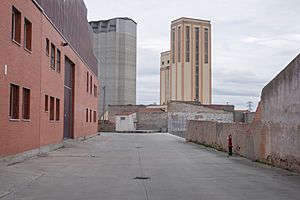
The main industries in Medina del Campo are furniture (like Castill Confort) and metal products (like MADE S.A.). The food industry (such as Productos Casado) is also important. The service sector has a special place in Medina's history because of its long tradition of Fairs. Today, the town offers many services, including government offices and shops. These are mostly found in the historic center.
Most of the land around Medina del Campo is dry. So, the most important crops grown are cereals. However, growing grapes for wine is also important in the northern part of the area.
Transportation
The town has a special test track for high-speed trains. It is also used for the Talgo RD Gauge Changer system. The other end of this track is in Olmedo, Valladolid.
Events and Festivals
The Holy Week in Medina del Campo has been officially named a Tourist Attraction. This is because of the beautiful religious statues and the long history of its processions. The Film Festival Week has been a meeting point for short-film makers from all over the world for 19 years. There is also a Sports Week in spring, a popular Half-Marathon, and a tennis tournament. The town is also famous for the National Greyhound Races Championship, which involves hare-coursing.
The local patron saint festival, San Antolín (Saint Antoninus of Pamiers), is held on September 2nd. The celebrations include religious ceremonies and, most importantly, bullfighting.
The encierros (Running of the Bulls) are very typical of Medina. This is when fighting bulls are let loose through the fields and along the city streets, leading them to the bullring. Also famous are the Dodges, called cortes in Spanish. In these, people go towards the bull and try to avoid it just as it attacks.
Sister Cities
 Montmorillon, France, since 1994
Montmorillon, France, since 1994 Zug, Western Sahara, since 2008.
Zug, Western Sahara, since 2008.
See also
 In Spanish: Medina del Campo para niños
In Spanish: Medina del Campo para niños



